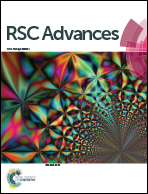Laccase immobilized on PAN/O-MMT composite nanofibers support for substrate bioremediation: a de novo adsorption and biocatalytic synergy
Abstract
The engineering of supports for enzyme immobilization while retaining competent functionality is nontrivial. We attempted to enhance the removal efficiency of organics by adopting a relatively novel approach involving a synergy from the adsorption capabilities of a support incorporated with organically modified montmorillonite (O-MMT) and catalytic properties of immobilized laccase. Electrospun polyacrylonitrile (PAN)/O-MMT membranes after alkaline hydrolysis and carboxyl activation were chosen as the support system for laccase immobilization. A confocal laser scanning microscope confirmed a uniform enzyme distribution along with the fibers' longitudinal surface. After enzyme immobilization, the optimum pH shifted from 3 to 3.5, while the optimum temperature remain unchanged at 50 °C. Its stability was preserved despite a large fluctuation in pH (50% of its initial activity retained over the pH range 2–6) and temperature (more than 80% of its initial activity retained over 30–70 °C). Compared to free laccase, the thermal stability of the immobilized laccase was improved after being under 30 °C and 50 °C for 8 h. The operational stability was 68% of the initial one after 10 times repeated usage, while also demonstrating 80% storage stability of the initial activity even after two months. The immobilized laccase showed a high removal efficiency of crystal violet at an optimum pH of 5 and temperature ∼40 °C as well as an initial substrate concentration of 100 mg L−1. Compared with that of the individual support and the free laccase, the removal efficiency by an immobilized enzyme is far higher to confirm a synergy in the immobilized enzyme and support system.


 Please wait while we load your content...
Please wait while we load your content...